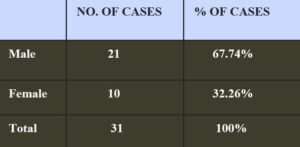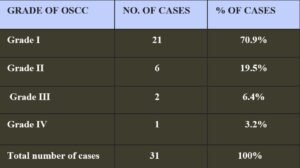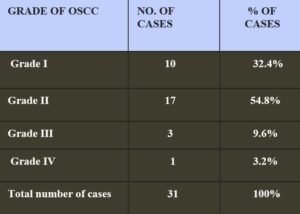A Comparative Study Between Anneroth’s And Broder’s Grading System Of Oral Squamous Cell Carcinoma In Relation To Histopathological Prognostic Factors- 6 Years Study

Global Journal of Pathology & Laboratory Medicine
Volume 1, Issue 4, August 2023
Received: March 31st, 2023, Reviewed: April 08, 2023, Accepted: April 10, 2023, Published: August 08, 2023
Unified Citation Journals, Pathology 2023, 4(4) 1-7; https://doi.org/10.52402/Pathology221
ISSN 2754-0952
Authors: Neethu G V1, Tejashwini K 2, Chanda Varshini Sindhiya 3
1Department of Pathology, Associate Professor, JJM Medical College, Davangere, Karnataka, India
2Department of Pathology, Postgraduate, JJM Medical College, Davangere, Karnataka, India
3Department of Pathology, Postgraduate, JJM Medical College, Davangere, Karnataka, India
Keywords: Oral Squamous Cell Carcinoma, Malignancy Grading System, Metastasis
Abstract: Oral cavity is one of the leading site of cancer. The incidence of oral cancer in India is 30-50% of whole body tumors. Histological grading is an important diagnostic tool to predict the clinical and biological behaviour of Oral Squamous Cell Carcinoma (OSCC). Analysis of the prognostic factors is important for predicting prognosis and reducing mortality in these patients. In1927 Broder’s grading system was formed for grading of OSCC, this system was applied for many years, then in 1978 Anneroth’s multifactorial grading system was established by Dr Anneroth, for evaluation of prognosis and prediction of survival period for oral squamous cell carcinoma patients. To compare Anneroth’s and Broder’s grading systems in OSCC and to evaluate Anneroth’s grading system as a standard when compared to Broder grading system. Retrospective study was done on 31 radical resected specimens. Cases reported as OSCC from year 2016-2021 in JJM Medical College, Davangere, Karnataka were included in the study. Statistical analysis done by calculating number and percentage cases of different grades of OSCC according to Broder’s and Anneroth’s grading system. Chi-square test was applied, p was value is calculated. Out of 31 cases, most common age group affected was above 50 years with male preponderance. As per Broder’s system 70.9% belongs to Grade I, 19.5% Grade II, 6.4% Grade III & 3.2% Grade IV. Whereas according to Anneroth’s system, out of 31 cases, 32.4% are Grade I, 54.8% are Grade II, 9.6% are Grade III & 3.2% are Grade IV. Anneroth’s grading system is more informative and gives better result regarding prognosis and prediction of survival period than Broder’s System. Broder’s grading system is based only on percentage of degree of histological differentiation where as Anneroth’s system of grading includes degree of keratinization, nuclear pleomorphism, number of mitosis per high power field, pattern of invasion, lymphoplasmacytic infiltration and stage of invasion. There is seen a close relationship between degree of histological differentiation and incidence of lymph node metastasis. Hence Anneroth’s system of grading can be taken as standard system for evaluation of prognosis and prediction of survival period in patient of OSCC.
1. Introduction
Oral squamous cell carcinoma (OSCC) is an aggressive neoplasm which is highly invasive and frequently metastasizes to cervical lymph nodes 1. Histological grading is an important diagnostic tool to predict the clinical and biological behaviour of oral squamous cell carcinoma. Analysis of the prognostic factors is important for predicting prognosis and reducing mortality in these patients. In 1927 Broder’s grading system was formed for grading of oral squamous cell carcinoma, this system was applied for many years, then in 1978 Anneroth’s multifactorial grading system was established by Dr Anneroth, for evaluation of prognosis and prediction of survival period for oral squamous cell carcinoma patients. There is seen a close relationship between degree of histological differentiation and incidence of lymph node metastasis. 2,3 Broder initiated histopathological grading system which was mainly based on differentiation as Grade I, II, III & IV with characteristics showing undifferentiated cells of 0-25%, 25-50%, 50-75% and 75-100% respectively. Later, multifactorial grading systems was introduced by Anneroth et al, which included features of tumor per se and tumor host interface4 (Figure no 1). Each histopathological parameters were scored from 1-4. Then the sum of scores were grouped as Grade I, II, III & IV with scores 5-10, 11-15, 16-20 & >20 respectively.
Aim of the study is to Compare Anneroth and Broder’s grading systems in oral squamous cell carcinoma and to evaluate the Anneroth’s grading as a standard as compare to Broder grading system.
2. Material and Methods
2.1 Source of data
Cases reported as OSCC from year 2016-2021 in JJM Medical College, Davangere, Karnataka, India.
2.2 Method of collection of data
2.2.1 Data archive
It is Retrospective study on total 31 radical resected specimen. Cases reported as OSCC from year 2016-2021 in JJM Medical College, Davangere, Karnataka are included in the study. Retrieved slides from departmental archives are analysed by 2 pathologists and all cases are reclassified according to Anneroth’s and Broder’s grading system. Ethical Committee clearance had been obtained from our institution for this study.
2.2.2 Statistical analysis
Statistical analysis done by calculating number and percentage cases of different grades of OSCC according to Broder’s and Anneroth’s grading system. Chi-square test is applied, p value is calculated.
3. Results
Out of 31 cases, most common age group affected was above 50 years accounting for 61.29% and below 50 years was 38.7% (Table 1) with males 67.74% and females 32.26% showing male preponderance (Table 2).
TABLE 1: AGE WISE DISTRIBUTION OF CASES
TABLE 2: SEX WISE DISTRIBUTION OF CASES
TABLE 3: GRADING OF CASES AS PER BRODER’S SYSTEM
As per Broder’s grading system, out of 31 cases, 21(70.9%) belongs to Grade I, 6(19.5%) Grade II, 2(6.4%) Grade III & 1(3.2%) Grade IV. (Table 3)
According to Anneroth’s grading system out of 31 cases, 21 cases are of Grade I (32.4%), 6 Grade II(54.8%), 3 Grade III(9.6%) & 1 (3.2%)Grade IV. ( Figure 1 & Table 4)
Figure 1: Histological grading of Anneroth’s system 2,3
TABLE 4: GRADING OF CASES AS PER ANNEROTH’S SYSTEM
When compared between two grading system, Broder’s grading system defines grading based only on percentage of differentiation of squamous cells, most of the cases according to Broder’s grading system in fall in grade 1, followed by grade II, grade III and grade IV where as Anneroth’s grading system considers 5 parameters and defines grading, most of cases in Anneroth grading system fall in grade II, followed by grade I, grade III and grade IV. The p- value is 0.027187, result is significant at p < 0.05. (Table 5)
4. Discussion
Histopathologic parameters of prognostic significance in OSCC are 5 Keratinization- Tumors with moderate/minimum keratinization will have significantly higher lymph node metastasis, Pattern of invasion : Carcinomas infiltrating tissues as small aggregates/ single cells have a high metastatic rate than those with pushing margins, Mitosis : Frequency of mitosis is a good predictor of lymph node metastasis and Depth of invasion: Greater depth of invasion, bad is the prognosis. (Figure 2)
Broder initiated quantitative grading of cancer and his classification system used for many years.
A lack of correlation between Broder’s’ grading system and prognosis has been mentioned. One of main reasons is that, OSCC’s usually exhibit a heterogenous cell population with differences in degree of differentiation.1
Anneroth et al. developed a multi factorial grading system in order to obtain a more precise morphologic evaluation of of OSCC. Anneroth’s grading system included 3 parameters indicating histological feature of tumour and 3 parameters indicating tumour host relationship. Which helps us in detailed analysis and grading the cases according to scoring of each parameter.
Broder’s grading system describes degree of keratinisation which has comparatively less value as compare to pattern of invasion and number of mitosis for evaluation. A main difference between these two grading systems is that Broders’ grade considers features within the tumour only. Where as in Anneroth’s system show tumour cell features in addition to the relationship between the tumour and underlying connective tissue.
In this study, out of 31 cases, as per Broder’s system 70.9% belongs to Grade I, 19.5% Grade II, 6.4% Grade III & 3.2% Grade IV which was consistent with findings of 600 case study done by Ghanghoria S et al showing 52% cases of grade I, 40% cases grade II and 8% cases were grade III.8
Whereas according to Anneroth’s system in this study, out of 31 cases, 32.4% as Grade I, 54.8% Grade II, 9.6% Grade III & 3.2% Grade IV consistent with findings of 600 case study done by Ghanghoria S et al with 37% of grade I, 55% were grade II,7.0% were grade III and 1.0% were grade IV.8
When we compared our study with other similar studies done by Akther M el al and Doshi N et al (Table 6) we found that results was similar i.e. according to Broder’s system most of the cases belong to grade 1 while according to Anneroth’s grade 2 was most common.
TABLE 5: COMPARISON OF RESULT BETWEEN TWO GRADING SYSTEM
TABLE 6: COMPARISION OF PRESENT STUDY WITH OTHER SIMILAR STUDIES
Figure 2:
A) Abundant Keratinization B) Moderate Keratinization C) Marked Pleomorphism, 3-4 MF/HPF D) Well delineated pushing margins E) Infiltrating bands and strands F) Tumour cell invading muscle G) Moderate lymphocytic infiltration
A.  B.
B. 
5. Conclusion
Broder’s grading system is based only on percentage of degree of histological differentiation where as Anneroth’s system of grading includes degree of keratinization, nuclear pleomorphism, number of mitosis per high power field, pattern of invasion, lymphoplasmacytic infiltration and stage of invasion. There is seen a close relationship between degree of histological differentiation and incidence of lymph node metastasis. Hence Anneroth’s system of grading can be taken as standard system for evaluation of prognosis and prediction of survival period in patient of OSCC.
6. References
[1] Sciubba, James J. Oral cancer The importance of early diagnosis and Treatment. Am J Clin Dermato. 2001;2:239–51
[2] Anneroth G, Batsakis J, Luna M. Review of the literature and a recommended system of malignancy grading in oral squamous cell carcinomas. Scand J Dent Res. 1987;95:229–49.
[3] Anneroth G, Hansen LS. A methodologic study of histologic classification and grading of malignancy in oral squamous cell carcinoma. Scand J Dent Res. 1984;92:448–68.
[4] Doshi N et al Histological grading of oral cancer :A comparison of different system and their relation to lymph node metastasis National journal of community medicine.2011 :2 (1).
[5] Jamadar S, Narayan T V, Shreedhar B, Mohanty L, Shenoy S. Comparative study of various grading systems in oral squamous cell carcinoma and their value in predicting lymph node metastasis. Indian J Dent Res 2014;25:357-63
[6] Mahmuda A et al. A study on histological grading of oral squamous cell carcinoma and its correlationship with regional metastasis 2005.
[7] Bryne M, Nielsen K, Koppang HS et al. Reproducibility of two malignancy grading systems with reportedly prognostic value for oral cancer patients. J Oral Pathol Med 1991; 20:369-72
[8] Ghanghoria S, Jaiswal S, Kiyawat P, Ghanghoria A. Comparison of Anneroth’s and Broder’s grading systems in oral squamous cell carcinoma- A 5 year study. JMSCR. 2019; 7:700-06
© Copyright 2023, All Rights Reserved. Use of this content signifies your agreement to the T&Cs of Unified Citation Journals
This abstract of Manuscript/Paper/Article is an open access Manuscript/Paper/Article distributed under the Creative Commons Attribution License (https://creativecommons.org/licenses/by/4.0/) which allows and permits unrestricted use, distribution, and reproduction in any medium, provided the original work is properly cited and accepted.
This communication and any documents, or files, attached to it, constitute an electronic communication within the scope of the Electronic Communication Privacy Act (https://it.ojp.gov/PrivacyLiberty/authorities/statutes/1285)
To citation of this article: Neethu G V1, Tejashwini K 2, Chanda Varshini Sindhiya 3, A Comparative Study Between Anneroth’s And Broder’s Grading System Of Oral Squamous Cell Carcinoma In Relation To Histopathological Prognostic Factors- 6 Years Study, Global Journal of Pathology & Laboratory Medicine
Upcoming Conferences;
- Emirates Pathology, Digital Pathology & Cancer Conference
More Details: https://pathology.universeconferences.com/
Submit your abstract/research papers/case- study here: https://pathology.universeconferences.com/submit-abstract/
Attend as a Speaker/Poster/Delegate In-person kindly register here: https://pathology.universeconferences.com/registration/
Attend as a Speaker/Poster/Delegate virtually kindly register here: https://pathology.universeconferences.com/virtual-registration/








 D.
D. 
 F.
F. 